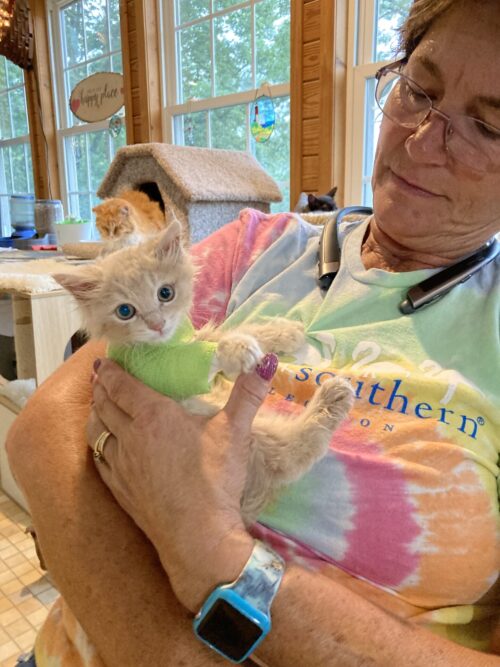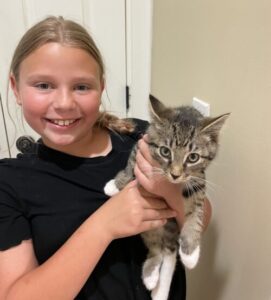
Special to IFN
Jay Braxton works in the motorsports industry and travels a lot. He loves animals but doesn’t consider himself a cat person. Anita Wize is a part-time Hospice nurse who loves caring for others and hosting Bible study in her home.
On the surface, the two couldn’t be more different, but they share something in common: Having both dealt with a feral cat problem in their respective neighborhoods, they became involved in a countywide effort to control the overpopulation of often unseen feral, stray and free-roaming cats otherwise known as “community cats.”
Community cats join together, creating “colonies” to survive and – for the ones that haven’t been spayed or neutered – to breed prolifically.
“These cats can be feral – unsocialized to humans – or friendly and social – like perhaps an abandoned pet – and any shade in between,” said Amelia Schaeffer, a volunteer with Iredell County Animal Services (ICAS), Lake Norman Lucky Cats (Lucky Cat) and Piedmont Animal Rescue (PAR).
Jay Braxton’s neighborhood
Community cats have litters of kittens wherever they can. In Braxton’s case, it was under his back porch. Braxton’s grandson lives with him in Mooresville and claimed one of the kittens, bringing it indoors, though it took his grandfather a few days to figure that out.
“So that ended up being my pet,” Braxton said, laughing. “I started looking for a low-cost option to get the cat spayed, and there was a six- to eight-week lead time on these appointments. I couldn’t believe it.”
The long wait, according to Lucky Cat Executive Director Robin Byrd, is due to a nationwide shortage of veterinarians and veterinary technicians and there is “no end in sight,” she said.
Braxton realized that, even once he spayed his new pet, her siblings were still under his porch and would themselves begin to produce yet more unwanted kittens.
“I knew I had to get all the cats fixed or I was going to have a problem,” he said. “We could end up having more cats than people in this neighborhood!”
That’s when he reached out to Schaeffer, who connected him with Lucky Cat, a non-profit that facilitates Trap-Neuter-Return (TNR) and low-cost spay/neuter services.
It turns out it wouldn’t be the last time he’d need them.
Community cat collaboration
Lucky Cat has joined with other local rescues and advocacy groups, including PAR, ICAS, Lake Norman Humane, Bella Vita Animal Rescue, Citizens for Animal Welfare, Stand for Animals, Catawba County Humane Society’s Foothills Spay/Neuter Clinic and the new Community Pets Mobile Veterinary Clinic to create the area’s “community cat collaboration.”
ICAS offers monthly TNR workshops for the public to learn how to trap a community cat. It also loans out the traps and has a limited number of free appointments available each month to spay or neuter the trapped animals. Afterward, the cat is returned to where it was trapped to be released.
TNR is the only humane, effective, long-term solution to reducing the number of community cats.
“Taking in and/or feeding cats without fixing them is not ‘rescue’ — it is irresponsible,” said Schaeffer.
If community members help with TNR, she explained, the size of community cat colonies would stabilize, the cat population would be controlled with no new kittens being born and cats would be healthier and vaccinated against rabies.
The cat breeding season starts in January or February – a time of year when most people aren’t thinking about kittens.
“Female kittens can and do become pregnant as young as four to five months old, and pregnancy lasts a mere 62 to 65 days,” said PAR’s cat coordinator, Dorie Shore. “Moms can get pregnant while they’re still nursing and go back in heat just four weeks after birthing a litter of four or five kittens. That means one female cat can feasibly have three or four litters of kittens every year.”
The problem isn’t just with female cats. Unneutered males roam, spraying their territories and seeking in-heat females and fighting over them, which can spread diseases. One male cat can mate multiple times a day with different females, Shore emphasized. This is how, practically overnight, a property can end up with dozens of feral cats on it.
Impact on rescues and shelters
During “kitten season,” which lasts from spring through autumn, Iredell County’s overburdened animal shelter and local rescues become even more inundated, and resources quickly dwindle. Still, they receive daily calls — sometimes dozens a day — from people looking to surrender pets or kittens and puppies they found or offspring their own pets birthed because they weren’t “fixed.”
Lucky Cat and Iredell County Animal Services recently spayed/neutered and vaccinated eight adults from a community cat colony through TNR. Lucky Cat’s paid partnership with PAR saved 13 sick kittens from the same colony, all of which PAR took in to care for until they could be adopted.
The partnerships shared among the collaboration mean everyone has skin in the game. Lucky Cat contributes to the cost that rescues incur in vetting an animal for adoption, and it asks the same of community members who call for TNR assistance.
“The community’s investment – whether it be through trapping, transporting or donating – is imperative to a successful outcome,” said Byrd.
Jackson, one of the 13 eight-week-old colony kittens recently accepted by PAR, had two broken back legs. Recognizing it was a fixable problem, Lucky Cat began raising funds to cover the cost of surgery, estimated at $4,000.
But the local nonprofit organizations, which rely almost entirely on community donations, have run out of resources. Rescues do not profit from adoption fees, Shore explained. A healthy kitten costs $150 to vet before it can be adopted, with those expenses increasing with injuries or illnesses. The cost of food and litter, until the animal is adopted, adds to the expense of rescuing.
Anita Wize’s neighborhood
Anita Wize’s neighbor was struggling with a feral cat problem years ago due to a nearby colony. She asked Wize to go with her to a Lucky Cat TNR presentation at the public library. The neighbor began trapping cats, and Wize became her “right-hand person” to help when needed. Sixteen years later, a lady in Wize’s Bible study mentioned she had outdoor cats, and she kept bringing them in to care for them. “She was 78, and I told her, ‘You can’t keep doing this,’” Wize remembered.

Having been to the TNR course, Wize knew what to do: “I called Amelia (Schaeffer). I didn’t think I could (trap the cats), but she kept encouraging me. I got my friend’s permission, and we started trapping.”
After having the cats spayed/neutered, Wize returned them to the original site, which is what they knew as their home. “We ended up getting 20-something cats TNR’d from that backyard colony,” she said. “I really felt rewarded.”
Wize eventually started fostering cats for PAR. Her experience as a nurse led her to care for many of the sick/injured cats the rescue takes in – including Jackson. “I became the infirmary,” Wize said, laughing. She has become quite the pro at TNR, too, having trapped and returned dozens of cats now.
“But that’s a drop in the bucket,” she said. “I’m just a beginner.”
Back to Braxton
Back in Braxton’s neighborhood, he trapped and returned his pet kitten’s siblings that were under his front porch. “And that should be the end of the story,” he said.
But it wasn’t. Braxton ended up with another litter … and another … under his porch.
“I had to go through this (TNR) ordeal all over again,” he said. “That makes 15 kittens I’ve taken care of at this point. This is a big problem.”
It took him more than a year, but he believes he’s found the source of his neighborhood’s problem — two male barn cats on a nearby property — so he approached a neighbor about trapping them and secured permission and plans to TNR those cats soon.
“But I’m just putting a band-aid on a much bigger problem,” Braxton acknowledged. “I’m just one guy. My motives are pretty selfish; I don’t need 45 cats living under my house.
“I never had any idea there was a problem like this, and when I finally did, there was no way to get a handle on it until I learned of the Lucky Cat Program.”
Added Lucky Cat’s Byrd: “Community cats are simply a symptom of a much larger problem — the people who fail to spay and neuter their cats or the cats they feed.”
The hard truth
North Carolina ranks third in the country — behind California and Texas – for the most animals killed in shelters, with 75 percent of those being cats. Entering a shelter is the primary documented cause of death for cats in the U.S.
Through a collaboration between Iredell County Animal Services, Lucky Cat and PAR, 1,158 cats/kittens – both pets and community cats – were spayed and neutered in the first five months of 2024.
Animal Services provides transport for cats every first and third Monday of the month to Foothills Spay and Neuter Clinic in Hickory. The county covers the entire cost of 15 TNR surgeries for unowned, free-roaming cats each month. These trapped cats receive spay/neuter, a rabies vaccine and an ear tip, which is the universal symbol of a cat having been spayed/neutered.
An additional 17 pet cats can also go on these transports. The cost to spay and neuter a pet cat is just $60 for females and $40 for males. Additionally, Lucky Cat and PAR have partnered to spay/neuter about 70 additional cats a month at Foothills, and the two joined with Stand for Animals in Mooresville to have another 189 cats sterilized since January 1 in an effort known as “targeted TNR.” This focuses on spaying/neutering all the cats in one colony before moving to surrounding colonies.
PAR now runs two monthly transports to Foothills for both cats and dogs with drop-off/pick-up locations in Mooresville and Statesville.
Shelters and local rescues – if they have space – have agreed to take in kittens only if arrangements are made to spay the mother cat.
“We cannot rescue, adopt or euthanize ourselves out of cat overpopulation,” said Byrd. “We must work at the root of the problem through spay/neuter.”
How you can help
• Have your pets spayed or neutered. This helps control the number of unwanted animals that end up overcrowding shelters and rescues.
• Attend Iredell County Animal Services’ TNR workshop at the Iredell County public library or shelter at 430 Bristol Drive. Follow the ICAS Facebook page for upcoming dates. With proper instruction and support, almost anyone can safely and successfully implement the TNR process.
• Donate. To continue to provide animal advocacy programs and services, non-profits/volunteers require community involvement through donations and volunteers.
• Foster animals through local rescues. Rescues are currently having to turn animals away, drastically increasing the chances that those animals will be euthanized in overcrowded shelters.
• Adopt an animal. Adoption gives animals a second chance at life while creating space in shelters and rescues for more animals in need.
• Participate. Everyone can do something, from donating and educating about the necessity/benefits of spaying/neutering to fostering, trapping and transporting to spay/neuter clinics.




A big thank you to the volunteers and rescue agencies who are angels to these precious creatures. We have a large cat colony in our neighborhood with no one taking action only feeding. It is shocking the prodigious rate at which they can reproduce. A mother cat may bear up to 5 litters per year at 6-10 kittens per litter. We were able to get help thanks to Amelia and was able to help save and spay/neuter those we’ve found.